Instant Artifact: The Highlander, Model 80A
To appeal to them, in 1954 Polaroid introduced a smaller camera called the Model 80. Here’s what it looks like:
It was also marketed as the “Highlander,” with a logo carpeted in plaid. 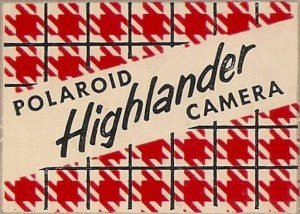 Judging by other cultural artifacts I’ve seen, this kind of name was often applied to products that were budget-priced. “Highlander” conveyed “Scotsman,” and “Scotsman” conveyed “thrift.” I vaguely remember Plaid Stamps, a discount system comparable to S&H Green Stamps, that carried the same connotation during my childhood. (Ethnic shorthand like this, common at the time, has—ahem—fallen out of favor. People are scunnered, as a Scotsman might say.)
Judging by other cultural artifacts I’ve seen, this kind of name was often applied to products that were budget-priced. “Highlander” conveyed “Scotsman,” and “Scotsman” conveyed “thrift.” I vaguely remember Plaid Stamps, a discount system comparable to S&H Green Stamps, that carried the same connotation during my childhood. (Ethnic shorthand like this, common at the time, has—ahem—fallen out of favor. People are scunnered, as a Scotsman might say.)
Here’s how the camera looks next to its overbearing husband:
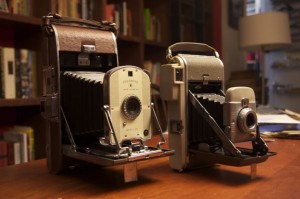 The difference appears modest, but when you pick the two up, it’s obvious that the Highlander is much lighter, and it’s a lot easier to wield, especially when you’re holding it up to your eye. It made correspondingly smaller photos, too–2 1/2 by 3 1/4 inches, instead of 3 1/4 by 4 1/4. The film produced under the name Type 42 for the big cameras was called Type 32 in the smaller format, and Type 47 corresponded to Type 37. (Much more about Polaroid roll films here, at the Land List.) Otherwise, though, it worked the same way. The photos processed themselves inside the camera, and were removed through a door on the back after they developed.
The difference appears modest, but when you pick the two up, it’s obvious that the Highlander is much lighter, and it’s a lot easier to wield, especially when you’re holding it up to your eye. It made correspondingly smaller photos, too–2 1/2 by 3 1/4 inches, instead of 3 1/4 by 4 1/4. The film produced under the name Type 42 for the big cameras was called Type 32 in the smaller format, and Type 47 corresponded to Type 37. (Much more about Polaroid roll films here, at the Land List.) Otherwise, though, it worked the same way. The photos processed themselves inside the camera, and were removed through a door on the back after they developed.
The Model 80 was a success, and stayed in production until 1961. Along the way it got a couple of tweaks, so later examples are marked 80A and 80B. This one is a Model 80A that belonged to Eelco Wolf, a longtime Polaroid marketing and corporate-communications executive. He gave it to me when I visited him recently–he said he was happy to have one more bit of clutter out of his house, and I was just as happy to acquire it.
And since I can’t resist adding to my own clutter, I recently found a matching accessory on eBay. Model 381 Shoulder Case, still in its box, never used. Nice heavy cowhide, burgundy corduroy interior, little elastic loop on the inside of the flap to hold your tube of print coater.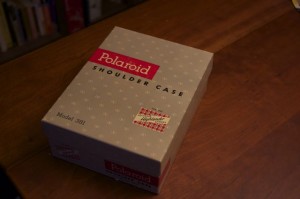
I’d love to try the camera out, but the 30-series films went out of production around 1980 or so, and any film that’s still around is almost surely dry and dead. (If I ever find some in a fridge somewhere, I’ll try it out. Unlikely to happen, even less likely to work.)
The case, however, will finally get out of its box and see some use. It turns out to be exactly the right size to hold a folding SX-70 camera and a pack of Impossible film, and the elastic doohickey will nicely hold the flash that Impossible and Mint have recently started selling. The only thing missing from this Shoulder Case, curiously enough, is the actual shoulder strap–it has a short handle, one you can’t slip your arm through. Someone must’ve swiped it long ago.
14 Responses to Instant Artifact: The Highlander, Model 80A
Leave a ReplyCancel reply
LEGALITIES
This site is not connected with or endorsed by Polaroid or PLR IP Holdings, owners of the Polaroid trademark.ON TWITTER
My TweetsBlogroll
- 'Insisting on the Impossible'
- Everything Reminds Me of You
- Flickr's Polaroid group
- Instant Options
- LandCameras.com
- Paul Giambarba: Analog Photography At Its Best
- Paul Giambarba: The Branding of Polaroid
- Polaroid
- Polaroid SF
- Rare Medium
- The Impossible Project
- The Land List
- The New55 Project
- Vintage Instant

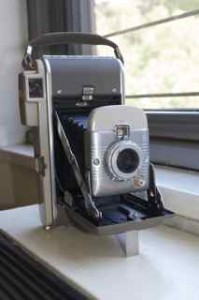







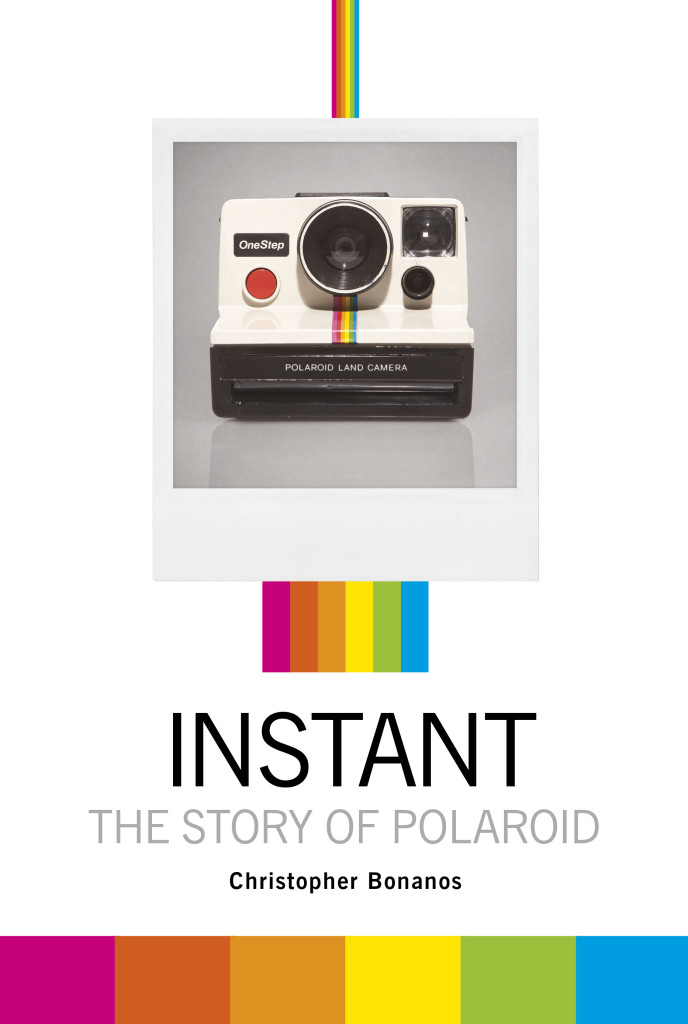
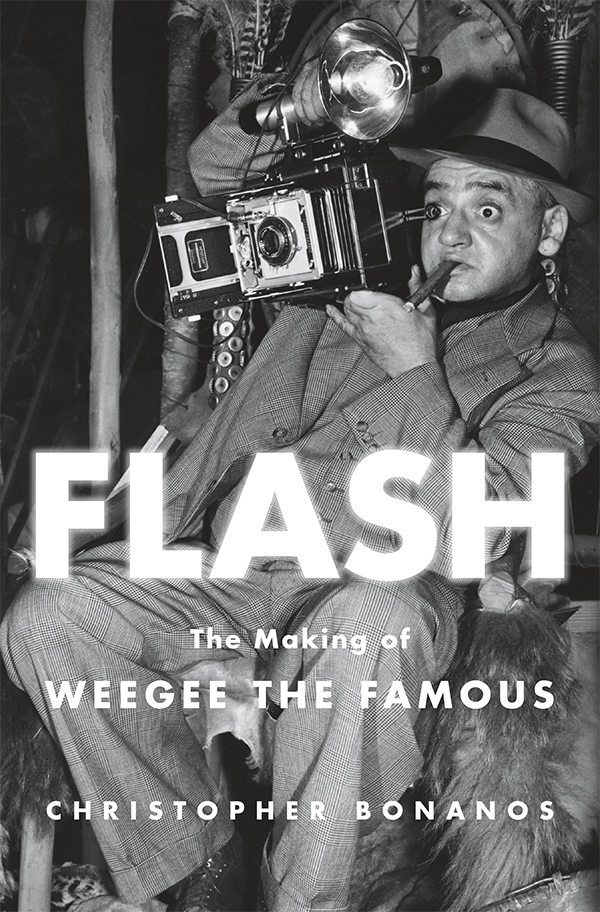
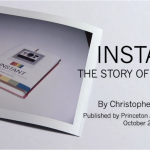

I have the 80B Highlander still in case with all paperwork and even an unopened roll of film (how dry would that be.). Apparently not worth much but interesting nonetheless. Just not sure what to do with it. Interesting history though.
I have one too. I would like to get the roll of film
Unfortunately, no more film for these. Discontinued almost 40 years ago, and any that is left has dried up and won’t work.
I’ve specifically collected the roll film cameras since the early 1980’stages. I have all of the camera’s EXCEPT the black Model 100, the 110B, and one of the Swinger models.
I am disappointed that the film is no longer available. I just brought into the house the Highlander 80A that my parents bought when I was a kid in the 50’s. Been sitting in a hot garage for a long time. I was hoping to try it out but alas, the comments indicate the film is long out of production.
Found some interesting blogs on how to convert this to use 120 film! Look it up it seems quite simple
Thank you, I’ll do that.
I recently acquired a Highlander 80. Albeit I don’t know whether it’s A or B model, I do know that it came with everything. The manuals, the camera, the bulbs, the Wink-Light, and alas; thankfully the ink and film, both which still are in mint condition. I’ve taken a few pictures and they are amazing. Whoever owned this camera before I do, they took great care of it.
I too have a model 80a which belonged to my grandfather. I am now 71 and will be passing this camera with its case and accessories to my grandson who is very interested in photography. I hope he will appreciate his Great Great Grandfather’s camera as well as continue to study photography as it use to be.
Can this camera use 700 film?
Afraid not. It takes Type 32 or 37 film, both of which have been out of production for more than 40 years.
There are adapters on Amazon.com that allow you to use 120 film in an 80a…
Video on YouTube!!!
You can use 120 roll film with an adapter from Amazon.com…
Instructions for same on YouTube!!!
You don’t just need the adapter to make 120 fit the camera.
You also need to add a winding knob that goes thru the top of the camera and has a ‘blade’ that fits the end of a 120 spool to wind the film onto a ‘take-up spool’. You have to carefully figure out.whst cooperative location you can drill a hole to do that step.
There is no red window to show you what exposure you are on and how far to wind to the next one. The back doors of the camera are usually two layers of steel. What some people do if they get this far is figure out with an already processed 120 negative how many winder turns will advance the film. You may need a film mask to keep the film where it belongs.
All this has been done B4 on 80’s, 95’s, 150’s and so one, so if you search long enough, you can find someone’s how to instrux.
Unfortunately, the current generation is doing other things like converting 95/110/150 to 4×5 sheet film, or shooting Fuji iInstax In an 80.
I don’t know where such instrux are specifically. I lost interest and have used 80 & 95 lenses on mirrorless cameras.
The adapter kit may provide the film mask feature I mentioned.